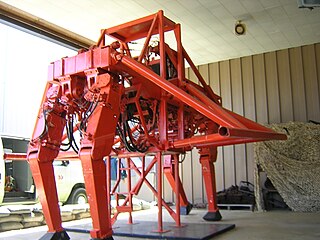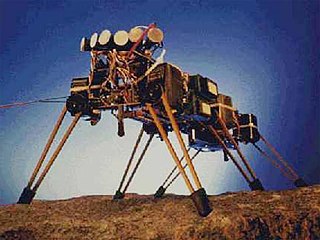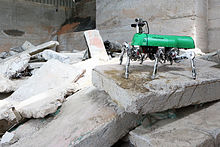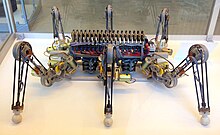Robot locomotion is the collective name for the various methods that robots use to transport themselves from place to place.
Bio-mechatronics is an applied interdisciplinary science that aims to integrate biology and mechatronics. It also encompasses the fields of robotics and neuroscience. Biomechatronic devices cover a wide range of applications, from developing prosthetic limbs to engineering solutions concerning respiration, vision, and the cardiovascular system.

BigDog is a dynamically stable quadruped military robot that was created in 2005 by Boston Dynamics with Foster-Miller, the NASA Jet Propulsion Laboratory, and the Harvard University Concord Field Station. It was funded by DARPA, but the project was shelved after the BigDog was deemed too loud for combat.
RAVON is a robot being developed at the Robotics Research Lab at University of Kaiserslautern, Germany. The vehicle is used as a testbed to investigate behaviour-based strategies on motion adaptation, localization and navigation in rough outdoor terrain. The basis vehicle was produced by Robosoft.

A six-legged walking robot should not be confused with a Stewart platform, a kind of parallel manipulator used in robotics applications.

Legged robots are a type of mobile robot which use articulated limbs, such as leg mechanisms, to provide locomotion. They are more versatile than wheeled robots and can traverse many different terrains, though these advantages require increased complexity and power consumption. Legged robots often imitate legged animals, such as humans or insects, in an example of biomimicry.
Boston Dynamics is an American engineering and robotics design company founded in 1992 as a spin-off from the Massachusetts Institute of Technology. Headquartered in Waltham, Massachusetts, Boston Dynamics has been owned by the Hyundai Motor Group since December 2020, but having only completed the acquisition in June 2021.

RunBot is a miniature bipedal robot which belongs to the class of limit cycle walkers. Instead of using a central pattern generator it uses reflexes which generate the gait. The reflexes are triggered by ground contact sensors in the feet which then activate the motors. The generation of the walking gait is straightforward: when a foot touches the ground the other leg is lifted upwards so that the robot falls forward. This then causes this leg to touch the ground and so forth. The walking speed can be improved by means of reinforcement learning because there are only a few parameters in this scheme. RunBot was built in 2005 by Tao Geng as part of his PhD under supervision of Prof Woergoetter and after an idea by Dr Porr to use a walking robot to benchmark reflex based reinforcement learning rules. Its movements and adaptability are based on the work of neurophysiologist Nikolai Bernstein.

RHex is an autonomous robot design, based on hexapod with compliant legs and one actuator per leg. A number of US universities have participated, with funding grants also coming from DARPA.

In robotics and computer vision, visual odometry is the process of determining the position and orientation of a robot by analyzing the associated camera images. It has been used in a wide variety of robotic applications, such as on the Mars Exploration Rovers.
The following outline is provided as an overview of and topical guide to robotics:

Bio-inspired robotic locomotion is a fairly new subcategory of bio-inspired design. It is about learning concepts from nature and applying them to the design of real-world engineered systems. More specifically, this field is about making robots that are inspired by biological systems, including Biomimicry. Biomimicry is copying from nature while bio-inspired design is learning from nature and making a mechanism that is simpler and more effective than the system observed in nature. Biomimicry has led to the development of a different branch of robotics called soft robotics. The biological systems have been optimized for specific tasks according to their habitat. However, they are multifunctional and are not designed for only one specific functionality. Bio-inspired robotics is about studying biological systems, and looking for the mechanisms that may solve a problem in the engineering field. The designer should then try to simplify and enhance that mechanism for the specific task of interest. Bio-inspired roboticists are usually interested in biosensors, bioactuators, or biomaterials. Most of the robots have some type of locomotion system. Thus, in this article different modes of animal locomotion and few examples of the corresponding bio-inspired robots are introduced.
Masakatsu G. Fujie is a Japanese scientist who has played a major role in cutting-edge research in biomedical engineering. He has been responsible for many advances in the field of robotics.
Atlas is a bipedal humanoid robot primarily developed by the American robotics company Boston Dynamics with funding and oversight from the U.S. Defense Advanced Research Projects Agency (DARPA). The robot was initially designed for a variety of search and rescue tasks, and was unveiled to the public on July 11, 2013.
MABEL is a robot engineered in 2009 by researchers at the University of Michigan, which is well known for being the world's fastest bipedal (two-legged) robot with knees. MABEL is able to reach speeds of up to 3.6 m/s (6.8 mph). The name MABEL is an acronym for Michigan Anthropomorphic Biped With Electronic Legs. The creators include J.W. Grizzle, Jonathan Hurst, Hae-Won Park, Koushil Sreenath, and Alireza Ramezani. MABEL weighs 143 pounds with most of its weight being in the top torso area. The legs contain large springs and are jointed to form knees. The robot is attached to a safety boom for lateral stability.

A walking vehicle is a vehicle that moves on legs rather than wheels or tracks. Walking vehicles have been constructed with anywhere from one to more than eight legs. There are many designs for the leg mechanisms of walking machines that provide foot trajectories with different properties.

Genghis was a six legged insect-like robot that was created by roboticist Rodney Brooks at MIT around 1991. Brooks wanted to solve the problem of how to make robots intelligent and suggested that it is possible to create robots that displayed intelligence by using a "subsumption architecture" which is a type of reactive robotic architecture where a robot can react to the world around them. His paper "Intelligence Without Representation", which is still widely respected in the fields of robotics and Artificial Intelligence, further outlines his theories on this.

Auke Jan Ijspeert is a Swiss-Dutch roboticist and neuroscientist. He is a professor of biorobotics in the Institute of Bioengineering at EPFL, École Polytechnique Fédérale de Lausanne, and the head of the Biorobotics Laboratory at the School of Engineering.

An insectoid robot is a, usually small, robot featuring some insect-like features. These can include the methods of locomotion, methods of navigation, and artificial intelligence based on insect models. Many of the problems faced by miniature robot designers have been solved by insect evolution. Researchers naturally look to insects for inspiration and solutions.













